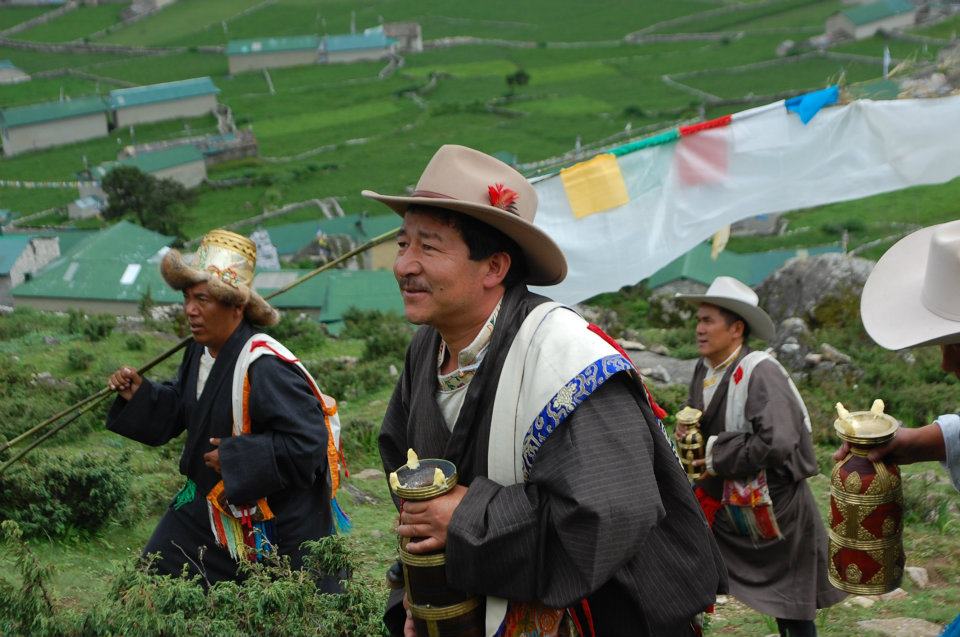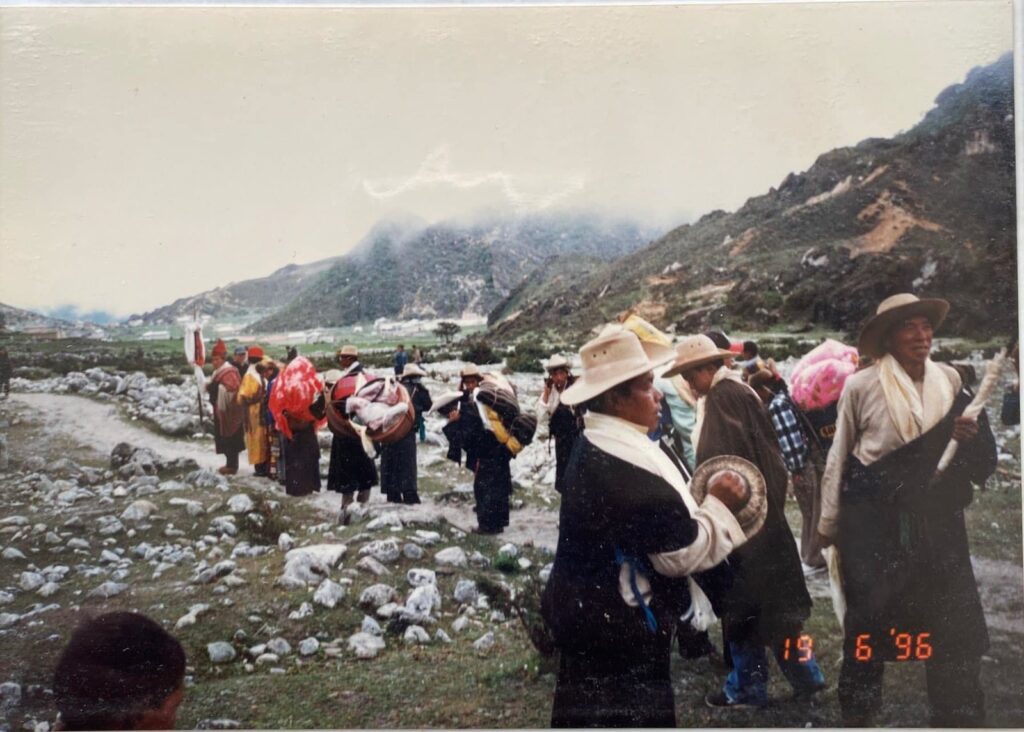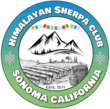Sherpa Prayers and Traditions
Sherpa Prayers

The Sherpas’ prayers to the small deities all around them are called Lha Chödub.
Sherpas recite these prayers because it is important to reflect before beginning any task. For example, if you keep yourself and your home clean, you are less likely to fall ill. Similarly, if you pray, the deities will support you in your good endeavors. Even if your enemies wish you bad luck, their efforts will not succeed.
During the third month, Sherpas pray for a good harvest. In the sixth month, they perform Yerchang, a ritual to bring luck to their herds and animals. Sherpas also offer prayers when building a new house or before embarking on a long journey.
There are different deities to worship during life and others at the time of death. Shitro prayers are offered to two kinds of deities at once:
Shiwa – kind and benevolent deities.
Trowo – wrathful and fierce deities.
The Thoedol describes these deities. Shitro may be performed for someone while they are still alive (Shitro Srog-ngo) or as part of their funeral rites.
Nyungne is a special puja dedicated to Phakpa Chenrezig. This puja is performed on significant days, such as when the Buddha attained Dewachen (liberation). It may be conducted for the benefit of an entire village or within one’s home.
During Nyungne, the participants—villagers, anis (nuns), and thrawas (monks)—follow strict practices:
On the first day, they eat only one meal but abstain from meat and chang (local beer).
On the following two days, they observe complete fasting—no food, water, or even swallowing saliva—and maintain absolute silence.
Throughout the three days, they engage in prostrations and prayers.
Sherpa Weddings

A Sherpa wedding consists of several stages:
Sodene – the engagement or proposal.
Demchang – the formal agreement, which sets the year and month of the final ceremony.
Pechang – the consultation to determine the exact date of the wedding.
Zendi – the final ceremony, during which the bride moves into the groom’s home.
For the Sodene, the local village lama is invited to the groom’s house to perform a puja called Serkim. The groom’s relatives gather for a meal before going to the bride’s house to formally propose. They bring chang (rice beer) specially brewed for the occasion. If the bride and her parents accept the proposal, the Zendi ceremony is scheduled anytime between one month and two years later. A special day is chosen, and the families call the ngagpa (village lama) to perform the puja for the Zendi.
The Zendi begins with the Lhapsang puja, first conducted at the groom’s house. His family prepares tso (special cones of cooked rice) and displays the kholu (a flag symbolizing the wheel of life). All of his relatives gather to eat and drink. Then, the procession moves to the bride’s house, carrying more special chang, which they present to her parents and relatives. While offering the chang, they pray to Guru Rinpoche and present kattas (white ceremonial scarves) to her family.
A representative from each family then formally introduces the families and offers blessings for good fortune. The village lamas compose a speech for this occasion, known as the mola, which must be read by an experienced speaker.
The bride’s family gifts her presents and property as part of her official inheritance. A group of carefully chosen young women—who have both parents and are considered lucky—carry these belongings in a procession to the groom’s home. Along the way, the groom’s relatives and neighbors meet the procession at designated points to welcome the couple and present chang and kattas. This welcoming tradition is repeated when they arrive at the groom’s house.
Sherpa Funerals
The sem is the mind of a person, while the loong is the energy of their mind. After death, the loong (energy) leaves the body but continues to exist.
When a person dies, a lama is called to perform Phowa, a ritual aimed at guiding the spirit. The lama performing Phowa must merge his energy with that of the deceased to generate positive energy for their transition. He uses prayers and pulls the deceased’s hair to encourage the spirit to leave through the head.
A person’s body heat may exit from various points, such as the soles of the feet, hands, eyes, ears, nose, mouth, or the top of the head. The spirit follows the path of this exit. If it leaves through the front or back passages, it is believed to lead to an unfortunate rebirth. Exiting through the nose or eyes may result in rebirth as either an animal or a human. However, if the spirit departs through the crown of the head, it may reach Dewachen (a pure realm). The lama conducting Phowa must be well-practiced in meditation to direct the spirit toward the head and prevent it from leaving through undesirable pathways.
Later, lamas sit by the body and read the Thoedol—instructions guiding the spirit on which path to follow in the afterlife. They continue praying and offer tsog (ritual offerings).
Funeral customs vary, but typically, the body is kept for three days before being taken to the cremation site. After being washed, the body is cremated as an offering to the deities.
Special prayers, called Dum, are conducted every seven days following the death. Depending on the family’s financial situation, these prayers can continue for up to fifteen days. A Shitro ritual is also performed to purify and gain merit for the deceased’s spirit. Even if a person has never practiced meditation in their lifetime, Shitro is believed to cleanse their spirit.
For example, if gold is dirty and blackened, heating and cleaning it can restore its shine. Similarly, our minds are unstable, clouded by desires and aversions—like dirt on a window. Through prayers, meditation, and Shitro rituals, we can cleanse this “window” to perceive ourselves more clearly.
Each evening, the family places sur (an offering of tsampa) on hot coals as food for the spirit of the deceased. The Bar-do is the state of existence between lives. By the end of 49 days after death, the person’s next life is determined, and they may be reborn.
When a child under the age of eight passes away, a special funeral called Len-chang torma is performed for the child’s benefit and that of the parents. During the ceremony, tormas and tsampa food pellets are replaced hourly during prayer repetitions. The funeral lasts between three and four days, sometimes extending to fifteen.
Dung-chog is a puja (ritual) performed for high lamas. While it appears similar to Phowa, its purpose differs. Dung-chog is conducted later to allow the lama’s mind and energy to disengage. This energy is believed to travel to a deity’s pure realm, from where it may reincarnate. The Dung-chog puja helps smooth the path this energy must follow.
Some content on this page is adapted from the book Story and Customs of the Sherpas by Frances Klatzel, based on the stories told by Tengboche Rinpoche, Ngawang Tenzin Zangbu. All rights belong to the original authors.
